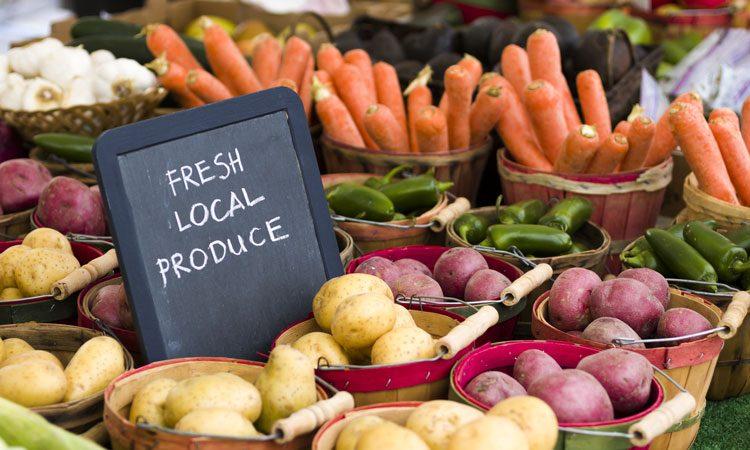In a world where the global marketplace offers strawberries in December and pumpkins in April, the art of eating seasonally and locally often feels like a lost tradition. Yet, this age-old practice is making a resurgence as more people seek to reconnect with the rhythms of nature and the bounty of their own backyards. Imagine biting into a sun-ripened tomato, its flavor a perfect harmony of sweetness and acidity, or savoring the crisp, earthy crunch of freshly harvested autumn apples. These experiences are not just culinary pleasures; they are a testament to the myriad benefits that eating seasonally and locally can offer. From enhancing nutritional value and reducing environmental impact to supporting local economies and fostering a deeper connection with the land, embracing this approach to food can transform not only our plates but our perspectives. Join us as we explore the compelling advantages of aligning our diets with the natural calendar and local harvests, and discover how this simple shift can enrich our lives in unexpected ways.
Nourishing Your Body with Seasonal Flavors
Eating in harmony with the seasons not only brings a delightful variety of flavors to your table but also infuses your meals with optimal nutrition. Seasonal produce is harvested at its peak, which means it retains more nutrients compared to out-of-season alternatives that may travel long distances. When you choose to eat seasonally, you are often supporting local farmers, reducing your carbon footprint, and indulging in the freshest ingredients available.
Incorporating local, seasonal foods into your diet can also be a feast for your senses. Imagine biting into a juicy, sun-ripened tomato in summer or savoring the earthy sweetness of roasted root vegetables in winter. These experiences not only enhance your meals but also connect you with the rhythms of nature. Consider adding the following seasonal delights to your grocery list:
- Spring: Tender asparagus, crisp peas, and vibrant strawberries.
- Summer: Sweet corn, juicy berries, and fragrant herbs.
- Autumn: Hearty pumpkins, apples, and squash.
- Winter: Nutritious kale, Brussels sprouts, and citrus fruits.
By embracing the bounty of each season, you not only enjoy a diverse palate but also nurture your body with the freshest, most nutrient-dense foods nature has to offer.

Supporting Local Farmers and Sustainable Practices
- Fresher Flavors: By choosing produce that’s in season, you’re not only getting the most flavorful and nutrient-rich options but also supporting the local economy. Seasonal fruits and vegetables are harvested at their peak, offering a taste that imported goods simply can’t match.
- Environmental Benefits: Eating locally reduces the carbon footprint associated with long-distance transportation. It supports sustainable farming practices that prioritize soil health, biodiversity, and minimal pesticide use, contributing to a healthier planet.
- Economic Support: Purchasing from local farmers keeps money within the community, helping to sustain small-scale agriculture. This economic support ensures that farmers can continue to grow crops that are suited to the local climate, rather than being forced to adopt industrialized farming methods.
- Connection to Community: Visiting local markets fosters a sense of community and allows consumers to form relationships with the people who grow their food. This connection creates a more meaningful food experience and encourages mindful consumption.
Embracing a diet that reflects the changing seasons not only enhances the quality of your meals but also nurtures a sustainable food system. By prioritizing locally-sourced produce, you contribute to a cycle of growth that benefits the environment, economy, and your own well-being.
Enhancing Nutritional Value through Seasonal Choices
Choosing foods that are in season can significantly boost their nutritional value. Seasonal produce is often harvested at its peak ripeness, ensuring that fruits and vegetables are packed with vitamins, minerals, and antioxidants. This freshness not only enhances their flavor but also maintains their nutritional integrity. By selecting locally sourced, seasonal items, you support sustainable farming practices, which often involve fewer pesticides and chemicals. This means you’re not only consuming healthier produce but also contributing to a healthier planet.
Opting for seasonal choices can also diversify your diet, introducing you to a variety of nutrients that may not be present in your usual selections. Some benefits of this approach include:
- Improved taste and quality: Seasonal produce is fresher and more flavorful.
- Cost-effectiveness: Locally grown, in-season items are typically more affordable.
- Environmental impact: Reduces the carbon footprint associated with long-distance food transport.
- Community support: Encourages the local economy and small-scale farmers.
Embracing the natural cycles of produce not only enhances your meals but also supports a more sustainable lifestyle.

Cultivating Community Connections through Local Foods
Embracing the rhythm of the seasons by choosing to eat what’s available locally offers a bounty of benefits that go beyond mere nutrition. When you indulge in seasonal produce, you are not only savoring food at its peak flavor but also supporting local farmers who nurture these crops with care. This connection fosters a resilient community network that thrives on mutual support and sustainability. Seasonal eating is a celebration of variety, as each time of the year brings its own set of unique tastes and textures, inviting you to explore new culinary experiences.
By prioritizing local foods, you contribute to a reduced carbon footprint, as these goods require less transportation and refrigeration. This conscious choice supports the environment and promotes biodiversity, encouraging the growth of native plants and the preservation of regional agriculture. Some key advantages of eating locally include:
- Fresher Produce: Locally sourced foods are often harvested at their prime, ensuring superior taste and nutritional value.
- Economic Growth: Buying from local producers helps bolster the local economy, creating jobs and fostering community development.
- Environmental Impact: Shorter supply chains mean less pollution and waste, contributing to a healthier planet.
- Community Engagement: Local food markets and events offer opportunities to connect with neighbors and learn more about food origins.
Final Thoughts
As we wrap up our exploration into the benefits of eating seasonally and locally, it’s clear that this mindful approach to food offers more than just a meal—it offers a connection. A connection to the rhythms of nature, to the community of growers and producers in our neighborhoods, and ultimately, to a more sustainable future. By choosing to align our plates with the seasons and our purchases with local markets, we embrace a lifestyle that nourishes not only our bodies but also our environment and economy. So next time you fill your basket, consider the journey of each item and the story it tells. In doing so, you become a part of a larger narrative—one that celebrates the richness of our local landscapes and the wisdom of eating in harmony with the earth’s natural cycles.


































